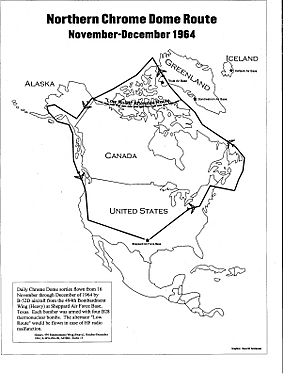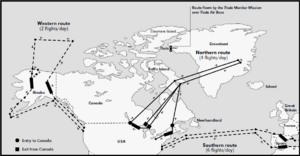Operation Chrome Dome facts for kids
Operation Chrome Dome was an important mission carried out by the United States Air Force during the Cold War. From 1960 to 1968, large B-52 bomber planes flew constantly in the air. These planes carried thermonuclear weapons, which are very powerful bombs. Their job was to fly routes near the border of the Soviet Union. This was done to be ready for any sudden attack.
Contents
What Was the Cold War?
The Cold War was a long period of tension between the United States and the Soviet Union. It lasted from the end of World War II until about 1991. During this time, both sides had many nuclear weapons. They were always worried about a possible war, but they never directly fought each other. Instead, they competed in many other ways, like in space and with their armies.
To keep peace, both sides tried to show they were strong. This idea was called "deterrence." It meant having enough power to stop an enemy from attacking.
Why Operation Chrome Dome Started
During the Cold War, a general named Thomas S. Power started a program for B-52 planes. These planes would stay in the air all the time. This was called "airborne alert." The goal was to be able to strike back very quickly if a nuclear war started.
Other similar missions had names like Head Start and Round Robin. The planes would fly near the borders of the Soviet Union. This way, they could respond fast if needed.
How the Missions Worked
1964 Flight Path
In 1964, a B-52D bomber would start its journey from Sheppard Air Force Base in Texas. It flew across the United States to New England. Then, it headed out over the Atlantic Ocean.
Over the Atlantic, the plane would get more fuel from another aircraft while flying. This is called "refueling." After refueling, it flew north towards Newfoundland. The bomber then changed direction and flew northwest over Baffin Bay towards Thule Air Base in Greenland.
From Greenland, it flew west over the Queen Elizabeth Islands in Canada. The journey continued to Alaska. The plane refueled again over the Pacific Ocean. Finally, it flew southeast and returned to Sheppard Air Force Base.
Later Missions in 1966
By 1966, the program had three different flight paths:
- One mission flew east over the Atlantic Ocean and the Mediterranean Sea.
- Another mission went north to Baffin Bay, similar to the 1964 route.
- A third mission flew over Alaska.
Military Groups Involved
Many different parts of the United States Air Force helped with Operation Chrome Dome. These included:
- Strategic Air Command groups, like the 306th Bombardment Wing.
- Bases such as Homestead Air Force Base in Florida.
- Units like the 2nd Bomb Wing from Barksdale Air Force Base in Louisiana.
Accidents During the Program
Operation Chrome Dome was a risky mission. Sadly, there were several accidents involving planes carrying nuclear weapons. These accidents included:
- The 1961 Goldsboro B-52 crash
- The 1961 Yuba City B-52 crash
- The 1964 Savage Mountain B-52 crash
- The 1966 Palomares B-52 crash
- The 1968 Thule Air Base B-52 crash
The accident near Thule Air Base in Greenland happened on January 22, 1968. This event led to the end of the Operation Chrome Dome program.
Images for kids
-
B-52 Airborne Nuclear Alert route from Homestead AFB, FL to Italy
See also
 In Spanish: Operación Chrome Dome para niños
In Spanish: Operación Chrome Dome para niños




